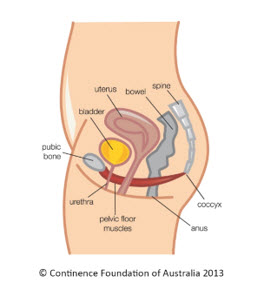This week’s blog comes from an accredited Exercise Physiologist (AEP), Matthew Koroneos, from MK Movement. Exercise Physiologists and Personal Trainers both use various exercises to improve the health of their clients, however, Exercise Physiologists may wish to specifically focus their practice on individuals who have been impacted by disease or chronic illness to help improve that person’s physical wellbeing.
Matthew is going to talk today about the Pelvic Floor. I wrote about this some time ago, but thought it wouldn’t hurt to hear some words of wisdom from an AEP. Although not all of you have had children, for those of you who have, you may find this blog useful!
Learning about the Pelvic Floor – what is it and how to train it?
At some stage or another, most people would have heard about the Pelvic Floor (PF). The purpose of this blog is to educate you more about its function and how we can correctly identify and train it.
Current research shows that PF muscle exercises are effective (with 84% cure rate) for most women with a diagnosis of urinary incontinence from having instrumental births or big babies, and/or for those with an overactive bladder.
What is it?
The PF is a layer of muscles which support the pelvic organs that lie on it. In women it supports the bladder, bowel and uterus (womb).
The PF muscles support the weight of the baby during pregnancy and assist with the birthing process by providing a firm yet elastic floor to allow the passage of the baby through the vagina.
Imagine the PF muscles as a round mini-trampoline, made of firm muscle. As with the mat of a trampoline, the PF has the potential to move down and up. The bladder, uterus and bowel lie on the pelvic floor muscle layer as mentioned earlier. Now imagine a hole in the trampoline for the passages to pass through. There are three passages in women (the urethra, vagina and anus). The PF muscles normally wrap quite firmly around the hole in the trampoline to keep the passages shut.

Figure 1: Diagram of Pelvic Floor Muscles in Women (Continence Foundation of Australia)
When might you see issues with your PF?
- Pregnancy – They can get too loose and weak, especially with women because they have been stretched during childbirth.
- High impact exercises – i.e. high impact sports such as basketball, netball or running increase chances of urinary incontinence.
How do you know if you have weak pelvic floor muscles?
- Accidentally leaking urine or faeces when coughing, sneezing, laughing, lifting or exercising.
- Having to get to the toilet quickly.
- Difficulty controlling bowel movements and wind.
- Feeling like you haven’t fully emptied your bladder or bowel.
What can you do to strengthen it?
The PF can be consciously controlled and trained, much like the arm, leg or abdominal muscles. If your ‘do-it-yourself’ pelvic floor muscle exercise program didn’t work, then chances are the exercises weren’t done the right way. No one should notice that you are working on your muscles- stay relaxed. Try the following exercises:
Exercise 1: Imagine you have a bowel full of wind and you’re at a party and you just can’t pass that wind. You need to hold onto it.
What to do: Close your backside and hold onto it for 5 seconds. Squeeze and contract as tightly as you can for a count of 5 then release.
Exercise 2: Imagine there is a red hot needle coming towards the vagina.
What to do: Lift and squeeze your vagina up inside the pelvis off the chair. Hold it up for a count of 5 then release.
Exercise 3: Imagine you’re on the side of the road and you’re having a wee. Now a busload of people come around the corner and you now need to stop that wee and hold it in!!
What to do: Clamp and hold for a count of 5 seconds then release.
Once you can complete all of these exercises individually, you could then combine them all and make it into one exercise in a seated position. Hold for 5 seconds. Complete 10 times in a row and complete up to 10 times per day if you’re in the rehabilitation phase for your PF muscles.
If you continue to experience issues, I would recommend seeing a trained health professional such as an Accredited Exercise Physiologist (AEP) or Physiotherapist who would be able to give you more specific tailored information about your PF.
Thank you for reading thus far and I hope you’ve learnt more about the PF. I am an Accredited Exercise Physiologist (AEP) and work across GP clinics and private practice in the north western suburbs as well as servicing semi/elite athlete teams.
You can find me on MK Movement on Facebook and Instagram for more content and info.
Please get in contact at mattykora@gmail.com if you have any questions or would like to schedule a consult. Private health rebates may apply!

